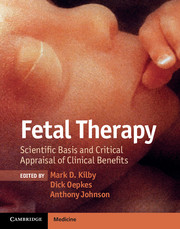Book contents
- Frontmatter
- Contents
- Contributors
- Foreword
- Preface
- Section 1 General principles
- Section 2 Fetal disease
- Chapter 6 Red cell alloimmunization
- Chapter 7 Fetal and neonatal alloimmune thrombocytopenia
- Chapter 8.1 Fetal dysrhythmias
- Chapter 8.2 Fetal dysrhythmias
- Chapter 9.1 Structural heart disease
- Chapter 9.2 Structural heart disease
- Chapter 9.3 Structural heart disease
- Chapter 10.1 Manipulation of amniotic fluid volume
- Chapter 10.2 Manipulation of amniotic fluid volume
- Chapter 11.1 Twin-to-twin transfusion syndrome
- Chapter 11.2 Twin-to-twin transfusion syndrome
- Chapter 11.3 Twin-to-twin transfusion syndrome
- Chapter 11.4 Twin-to-twin transfusion syndrome
- Chapter 11.5 Twin-to-twin transfusion syndrome
- Chapter 12.1 Twin reversed arterial perfusion (TRAP) sequence
- Chapter 12.2 Twin reversed arterial perfusion (TRAP) sequence
- Chapter 13.1 Fetal infections
- Chapter 13.2 Fetal infections
- Chapter 14.1 Fetal urinary tract obstruction
- Chapter 14.2 Fetal urinary tract obstruction
- Chapter 14.3 Fetal urinary tract obstruction
- Chapter 14.4 Fetal urinary tract obstruction
- 15.1 Fetal lung growth, development, and lung fluid
- Chapter 15.2 Fetal lung growth, development, and lung fluid
- Chapter 16.1 Neural tube defects
- Chapter 16.2 Neural tube defects
- Chapter 17.1 Fetal tumors
- Chapter 17.2 Fetal tumors
- Chapter 18.1 Intrauterine growth restriction
- Chapter 18.2 Intrauterine growth restriction
- Chapter 19.1 Congenital diaphragmatic hernia
- Chapter 19.2 Congenital diaphragmatic hernia
- Chapter 20.1 Fetal stem cell transplantation
- Chapter 20.2 Fetal stem cell transplantation
- Chapter 20.3 Fetal stem cell transplantation
- Chapter 21 Gene therapy
- Chapter 22 The future
- Glossary
- Index
- References
Chapter 19.2 - Congenital diaphragmatic hernia
clinical antenatal management
from Section 2 - Fetal disease
Published online by Cambridge University Press: 05 February 2013
- Frontmatter
- Contents
- Contributors
- Foreword
- Preface
- Section 1 General principles
- Section 2 Fetal disease
- Chapter 6 Red cell alloimmunization
- Chapter 7 Fetal and neonatal alloimmune thrombocytopenia
- Chapter 8.1 Fetal dysrhythmias
- Chapter 8.2 Fetal dysrhythmias
- Chapter 9.1 Structural heart disease
- Chapter 9.2 Structural heart disease
- Chapter 9.3 Structural heart disease
- Chapter 10.1 Manipulation of amniotic fluid volume
- Chapter 10.2 Manipulation of amniotic fluid volume
- Chapter 11.1 Twin-to-twin transfusion syndrome
- Chapter 11.2 Twin-to-twin transfusion syndrome
- Chapter 11.3 Twin-to-twin transfusion syndrome
- Chapter 11.4 Twin-to-twin transfusion syndrome
- Chapter 11.5 Twin-to-twin transfusion syndrome
- Chapter 12.1 Twin reversed arterial perfusion (TRAP) sequence
- Chapter 12.2 Twin reversed arterial perfusion (TRAP) sequence
- Chapter 13.1 Fetal infections
- Chapter 13.2 Fetal infections
- Chapter 14.1 Fetal urinary tract obstruction
- Chapter 14.2 Fetal urinary tract obstruction
- Chapter 14.3 Fetal urinary tract obstruction
- Chapter 14.4 Fetal urinary tract obstruction
- 15.1 Fetal lung growth, development, and lung fluid
- Chapter 15.2 Fetal lung growth, development, and lung fluid
- Chapter 16.1 Neural tube defects
- Chapter 16.2 Neural tube defects
- Chapter 17.1 Fetal tumors
- Chapter 17.2 Fetal tumors
- Chapter 18.1 Intrauterine growth restriction
- Chapter 18.2 Intrauterine growth restriction
- Chapter 19.1 Congenital diaphragmatic hernia
- Chapter 19.2 Congenital diaphragmatic hernia
- Chapter 20.1 Fetal stem cell transplantation
- Chapter 20.2 Fetal stem cell transplantation
- Chapter 20.3 Fetal stem cell transplantation
- Chapter 21 Gene therapy
- Chapter 22 The future
- Glossary
- Index
- References
Summary
Introduction
Congenital diaphragmatic hernia (CDH) is a congenital birth defect which occurs in 1 in 3000 to 1 in 5000 live births [1]. This number discounts what has been called the “hidden mortality,” i.e., stillbirths or neonatal deaths before transfer to a tertiary care center. Probably a more accurate estimate incidence of CDH is 1 in 2200 live births [2, 3]. Based on 5 420 900 live births in the European Union (EU-27) counted by Eurostat (2008), this means in absolute numbers at least every 4 hours one new case is born alive! According to a meta-analysis, up to 40% of cases have associated problems [4]. These can occur in the absence or presence of identified syndromes or other genetic problems. The presence of other anomalies is an independent predictor of neonatal death. The majority thus are apparently isolated and they are the actual subject of this contribution. The introduction of maternal ultrasound screening programs today lead to prenatal diagnosis in about two out of three cases, hence prenatal management options [5].
Herein we will discuss CDH from a perspective of antenatal management, including fetal intervention. Fetal surgery is only contemplated when five conditions are present, as defined by the International Fetal Medicine and Surgery Society (IFMSS) [6] (Table 19.2.1). We will discuss how this applies to CDH. We first summarize actual survival rates when this condition is managed after birth, essentially showing that there is no effective postnatal therapy in a subset of fetuses. In other words, the natural history of CDH has been identified (condition 2) and for some cases there is no effective postnatal therapy (condition 3). Key to fetal therapy is the fulfillment of condition 1, which means that there must be methods to tie the first two conditions together and have assessment methods that can predict poor outcome despite optimal postnatal care. We will summarize how such individualized prognosis can be made. Then we will summarize the experimental basis for fetal surgery (condition 4). Given all this, fetal therapy for CDH became a clinical reality. We describe the current clinical experience with fetal surgery, including the design of trials that will have to determine the place of fetal surgery (condition 5).
Keywords
- Type
- Chapter
- Information
- Fetal TherapyScientific Basis and Critical Appraisal of Clinical Benefits, pp. 376 - 388Publisher: Cambridge University PressPrint publication year: 2012



